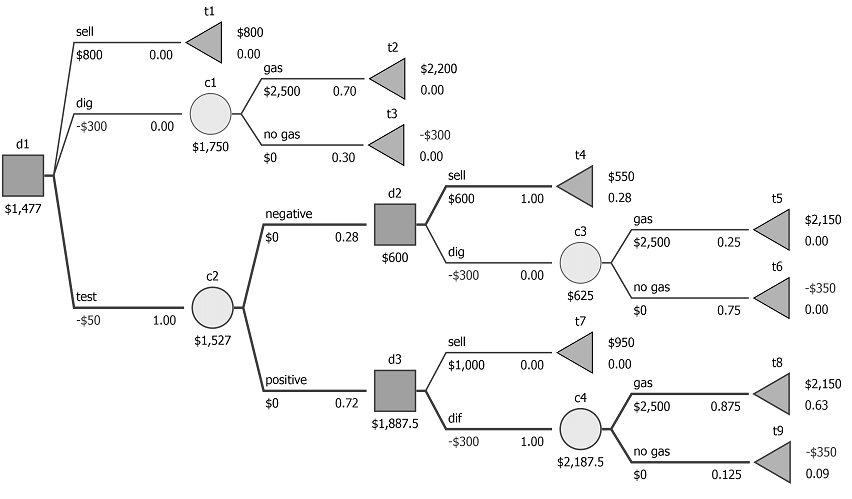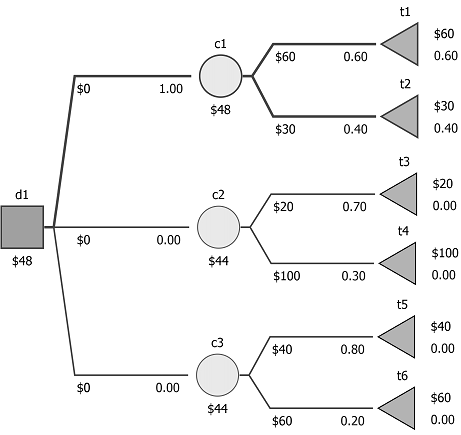Chondro - decision tree sensitivity analysis library
This is a library acompying paper: "A framework for sensitivity analysis of decision trees", Central European Journal of Operations Research, March 2018, Volume 26, Issue 1, pp 135–159 by Bogumił Kamiński, Michał Jakubczyk and Przemysław Szufel
https://link.springer.com/article/10.1007/s10100-017-0479-6
Very quick start
from chondro import *
t = load_tree("examples/case1.json")
print_tree(t)
solve_tree(t)
print_tree(t)
print(find_stability(t))
print(find_perturbation_pessopty(t))
print(find_perturbation_mode(t))
Library overview
(This is just an overview - the full documentation is available at https://github.com/pszufe/chondro/blob/master/docs/Chondro_v023.pdf)
Chondro – is an analytical engine that implements the decision tree (DT) sensitivity analysis (SA) algorithms. All the methods support both for separable and non-separable decision trees. Chondro has been developed with the Python3 and has been tested with Anaconda 2.5.1 running Python3 version 3.5.1.
The software can load files stored by the SilverDecisions software (available at
http://www.silverdecisions.pl) or can use an internal JSON format. A DT is
presented as a Python dictionary structure with each node described with
a type (choice,decision,final), id, value (pay-off), and a list
(nodes) containing child nodes. The probability values p (for
separable DTs) or identifiers pi (for non-separable DTs) are stored in
children nodes of a chance node. Chondro
supports non separable DTs through injection of probability values as a
dictionary. In order to perform stability and perturbation analysis for
non-separable decision trees a function that generates probability
dictionary on the base of fundamental probabilities should be provided
to a respective algorithm.
It should be noted that Chondro heavily relies on the Python fractions
package for numerical computing and hence enables calculation and
comparison of the exact values for P-optimal decisions. In this way we
managed to avoid numerical problems when expected values at different
nodes are equal.
Below you can find a sample separable decision tree and a corresponding JSON representation. The
probability and payoff values are given as string rather than number
values in order to enable a proper conversion with the fractions
module.
{
"tree": {
"type":"decision", "id":"d1",
"nodes": [
{
"type":"chance","id":"c1",
"nodes": [
{"p":"0.6","type":"final","id":"t1","value": "60" },
{"p":"0.4","type":"final","id":"t2","value": "30" }
]
},
{
"type":"chance","id":"c2",
"nodes": [
{"p":"0.7","type":"final","id":"t3","value": "20" },
{"p":"0.3","type":"final","id":"t4","value": "100" }
]
},
{
"type":"chance","id":"c3",
"nodes": [
{"p":"0.8","type":"final","id":"t5","value": "40" },
{"p":"0.2","type":"final","id":"t6","value": "60" }
]
}
]
}
}
A sample non-separable decision tree and a part of the corresponding JSON
representation.

{
"tree": {
"type": "decision", "id": "d1",
"nodes": [
{
"type": "final","label":"sell","id": "t1","value": "800"
},
{
"type": "chance","label":"dig","id": "c1","value": "-300",
"nodes": [
{
"pi": "gas", "label":"gas",
"type": "final", "id": "t2", "value": "2500"
},
{
"pi": "no_gas", "label":"no_gas",
"type": "final", "id": "t3", "value": "0"
}
]
},
{
"type": "chance","label":"test","id": "c2","value": "-50",
"nodes": [
{
"pi": "neg._test", "label":"negative",
"type": "decision", "id": "d2",
"nodes": [
{
"type": "final",
"label":"sell",
"id": "t4",
"value": "600"
},
(... in order to increase readibility only part og tree has been shown ...)
Sensitivity analysis of separable trees
A typical example session with Chondro might consist of the following steps:
-
create a JSON representation of a DT (either by saving a DT from SilverDecisions or manually creating a JSON file)
-
Use the function to load a DT to memory
-
Use the function to calculate optimal decision for the DT. The function supports non-separable trees by accepting a probability dictionary.
-
perform the sensitivity analysis
The Listing below presents a sample code to solve the decision
tree. We first start by loading the module. Next a
JSON file is loaded with the function. It should be noted that this
function supports JSON files in both internal dictionary format as well
as files that can be exported from SilverDecisions software (available
at http://www.silverdecisions.pl). The function solve
returns a tuple where the first element is the expected value of DT and
the second dictionary of optimal decisions.
from chondro import *
file_name = "example_separable_Fig5.json"
tree = load_tree(file_name)
ev,dec=solve_tree(tree)
print ("DT has been solved, the expected value is ev: "+str(ev)+ \
" reachable decisions: "+str(get_reachable(dec)))
print_tree(tree)
stabi = find_stability(tree,precision=Fraction("1/10000") )
print ("DT stability", stabi)
ress = find_perturbation_mode(tree,precision=Fraction("1/1000"))
print("DT perturbation mode",ress)
ress = find_perturbation_pessopty(tree,precision=Fraction("1/1000"))
for key in ress.keys():
print ("P_"+key, ress[key])
Sample output
d1:decision
*c1:chance (ev=48)
t1:p=3/5 final [60]
t2:p=2/5 final [30]
c2:chance (ev=44)
t3:p=7/10 final [20]
t4:p=3/10 final [100]
c3:chance (ev=44)
t5:p=4/5 final [40]
t6:p=1/5 final [60]
Sensitivity analysis of non-separable trees
The Chondro library is capable of processing both separable and non separable trees. Due to much larger computational complexity of non-separable the library has different internal implementation of stability and perturbation algorithms for both tree types. A sample non-separable decision tree has been presented in the first paragraph of this page.
The support for non-separable trees is achieved by providing to the
function an additional parameter derived_probs_dict that contains a
dictionary of key-probability values that can be injected into pi
fields in a decision tree. Hence, there are two differences in
processing non-separable DTs compared to separable ones:
-
probabilities in the decision tree are represented as keys rather than values and use
pifields instead ofpfields. -
in order to perform sensitivity analysis a function needs to be provided that transforms fundamental probabilities into dictionary of key-value pairs that can be injected by Chondro into
pifields in a DT
Calculating stability and perturbation requires performing a sweep over a set of fundamental probabilities and providing a function transferring those probabilities into a key-probability dictionary. Hence, the methods , and require providing two additional parameters:
-
derived_probs_lambda - a function that calculates derived probabilities on the base of fundamental ones. The function should return a dictionary where keys are corresponding to
pivalues in a decision tree. -
fundamental_probs - a list of initial vales of fundamental probabilities
An example function that calculates probabilities on the base of fundamental ones has been presented below
The initial values for fundamental probabilities is represented as a
list of events where each event is described by a list of outcome
probabilities. Moreover, if there are [[0.5],[0.25,0.25,0.25]].
In Listing below an example processing of a non-separable
decision tree has been presented. Firstly, fundamental probabilities
values need to be defined. Those values
can be used to calculate a P-optimal decision. Next, we defined s values
representing whether a particular event (for which fundamental
probabilities have been given) should be a subject of sensitivity
analysis. Finally, we perform the stability analysis - in our
computations we limit the maximum considered value of epsilon to
1.
def tree_derived_probs_lambda(probs):
p=dict()
p["gas"] = probs[0][0]
sensitivity = probs[1][0]
specifity = probs[2][0]
p["no_gas"] = 1-p["gas"]
p["pos._test"]=sensitivity*p["gas"]+ \
(1-specifity)*p["no_gas"]
p["neg._test"]=1-p["pos._test"]
p["gas|pos._test"]=sensitivity*p["gas"]/p["pos._test"]
p["no_gas|pos._test"]=1-p["gas|pos._test"]
p["gas|neg._test"]=(1-sensitivity)*p["gas"]/ \
p["neg._test"]
p["no_gas|neg._test"]=1-p["gas|neg._test"]
return p
from chondro import *
tree = load_tree("exaple_non_separable_fig7.json")
fund_probs = [[Fraction("7/10")],[Fraction("9/10")],[Fraction("7/10")]]
solve_tree(tree,tree_derived_probs_lambda(fund_probs))
print_tree(tree)
s = [1,0.1,0.1]
stabi = find_stability(tree,tree_derived_probs_lambda, \
fund_probs,precision=Fraction("1/100"),s=s,max_epsilon=1) )
print ("stability", stabi)
ress = find_perturbation_mode(tree,tree_derived_probs_lambda,\
fund_probs,precision=Fraction("1/100"),s=s,max_epsilon=1))
print("mode perturbation",ress)
ress = find_perturbation_pessopty(tree,tree_derived_probs_lambda,\
fund_probs,precision=Fraction("1/100"),s=s,max_epsilon=1) )
for key in ress.keys():
print ("P "+key, ress[key])
